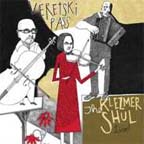Veretski Pass / The Klezmer Shul Live!

Veretski Pass / The Klezmer Shul Live!
Golden Horn Records, GHP-035-2, 2010
www.goldenhorn.com
CD available from Golden Horn Records and download from all popular vendors.
In previous reviews, I have often referred to Veretski Pass as being on the cutting edge of Jewish music, despite the fact that previous recordings have focused on very traditional Jewish styles from the Carpathian Mountains, long before that music met America. In this new recording, all of that is present, but now the modern avant garde and jazz elements are overt. To repeat myself, this is the cutting edge of Jewish music. More important, this particular piece, despite having little overt beyond the names of sections (or the overall name of the work) to reflect Jewish synagogue traditional, is intensely spiritual.
In describing the piece, the blog at Golden Horn Records (one of a very short list of record labels that seems to publish this kind of music and to put the effort into packaging and presenting it so that it is obvious that this is music worth listening to) begins:
In the 1000 year history of Ashkenazic culture, research has shown that there were Jewish trade guilds, which often established their own small synagogues, or shuls. There were shuls for tailors, shoemakers, stone cutters—and klezmorim (musicians). Inspired by these historic accounts, Stu Brotman obtained a grant from the Creative Work Fund in San Francisco for Veretski Pass to compose a klezmer-based, musical impression of a Jewish service…. [more]
The result is "a four movement suite that attempts to bridge the gap between the sacred and the secular, not through the use of words, but with purely instrumental music." Opening with Stu's plaintive "Call to gather" on tilinca (a wooden Romanian flute), the piece weaves in and out of styles, often returning to the traditional klezmer sounds and modes for which the band is acclaimed, but also frequently delving into other areas reminding us that music, like prayer, is most passionate when the players improvise and express what is on their hearts at the moment, and also that there probably aren't many ensembles that are so intuitively able to improvise, nor so musically experienced and adept.
Josh's tiny, wheezy, ancient button accordion on the "Shma," for instance, somewhere between klezmer and jazz, and then the growl of Stu's bass as the accordion steps back to rhythm and Cookie finds that sweet spot between traditional tefila and a more modern classical idiom on the "Yismekhu" (or later, on "Oseh Shalom" as her violin sings.
Much of that interplay is captured as the violin and cello converse in "Zingerl," interrupted abruptly by Josh switching to piano and taking us on a brilliantly jazzy of "Birkot Hashakhar II." The 3rd movement, overall, has to be my favorite movement. It is the most surprising, the one that, to my unexpecting ears, hit me hardest the first time I watched them play the piece. It is probably the first time I had witnessed Joshua Horowitz, jazz musician, and realized how much that I had heard as "klezmer" for years is informed by jazz … and how comfortably that medium fits his fingers. This isn't "Jewish jazz" in the sense of jazzified traditional yiddish and klezmer tunes—there is nothing of shmaltz here—this is davening in jazz. And when Cookie takes the lead again in "Where Can I Find You?" and an entirely stunning "Kaddish" we hear not just the hazonos of the tune, but years of New Haven Symphony and 20th century classical music in the quality of her prayer.
Before I close, I should be remiss in not mentioning the wonderful graphics of Matt Strieby, who perfectly captures the humor and depth of the band. The art used on the cover is available as a poster and, I believe as a t-shirt. All this, and more, is available from the band's online store.
I worry in describing this piece that I have made it sound inaccessible or too different to be easily slotted into a collection. It is true that this music resists categorization. How appropriate to greet the new year, Rosh Hashanah, with "The Klezmer Shul" and much joy, and to leave the worries about boxes to the packaging industry. This is modern shul music, and like the davening of the best of the old-time cantors, this is also music to open the heart to repentence and new beginnings; to hope, an awareness of the greater cosmos around us, and to the power of prayer and community. Get your own copy and you, too, will soon come to daven in "The Klezmer Shul." Amen.
Reviewed by Ari Davidow, 24 Sep 2011.
Personnel this recording:
Cookie Segelstein: violin
Joshua Horowitz: button accordion, piano
Stu Brotman: bass cello, tilinca
Songs
- Movement 1: Without Beginning
- Call to Gather 2:25
- A Voice Says Proclaim 3:17
- Silent Prayer 3:00
- Ma Tovu 1:29
- V'Shamru 1:01
- Movement 2: A Sign Upon Your Hand
- Birkat Kohanim 2:49
- Birkot Hashakhar I 1:30
- Shma 3:12
- Cadenza 0:26
- Yismekhu 1:47
- Movement 3: Remembrance
- Zingerl 3:32
- Birkot Hashakhar II 1:25
- Nign 2:33
- Binah 1:20
- Where Can I Find You? 1:38
- Kaddish 2:16
- El Mole Rakhamim 8:01
- Oseh Shalom 3:20
- Movement 4: The Wonder of Being
- Processional 0:51
- Kadosh, Kadosh, Kadosh 1:22
- Awe and Thanksgiving 1:54
- This Good World 0:42
- Pantilemon St. 1:13

